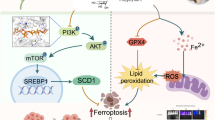Abstract
Flavopiridol and UCN-01 are two novel protein kinase inhibitors with diverse cellular effects that may complement each other with regards to induction of apoptosis. HeLa cells engineered to overexpress human survivin (HeLa-S) were at least ∼4.8-fold resistant to UCN-01 relative to proliferation observed in control HeLa cells (HeLa-V). Flavopiridol cytotoxicity as measured using the MTT assay was unaffected in HeLa-S cells when compared with HeLa-V cells. Similarly, simultaneous treatment of HeLa-V cells with flavopiridol and UCN-01 for 72 hours did not result in synergistic inhibition of proliferation; however, in HeLa-S cells, this combination resulted in synergistic inhibition of cell proliferation. Flavopiridol and UCN-01 augmented apoptosis in HeLa-S cells (as compared with HeLa-V cells) as measured by caspase-3 cellular activity assay, DNA fragmentation and PARP cleavage by western blot. In HeLa-V and -S cells, combination treatment resulted in caspase-8 cleavage. Caspase-9 was expressed in HeLa-V cells; however, there was a marked reduction of caspase-9 content in HeLa-S cells only. Combination treatment resulted in a significant reduction in survivin abundance in HeLa-S and SKBR3-UR cells, but not in their respective parental lines. The synergy of Flavopiridol and UCN-01 are selectively toxic to survivin-overexpressing cell lines and the mechanism of toxicity involves caspase-dependent cell death.
Similar content being viewed by others
References
Mani S, Wang C, Francis R, Pestell RG: Cyclin-dependent kinase inhibitors: novel anti-cancer drugs. Exp Opin Invest Drugs 9(10): 1849–1870, 2000
Kitada S, Zapata JM, Andreeff M, Reed JC: Protein kinase inhibitors flavopiridol and 7-hydroxy-staurosporine down-regulate antiapoptosis proteins in B-cell chronic lymphocytic leukemia. Blood 96: 393–397, 2000
Byrd JC, Shinn C, Waselenko JK, Fuchs EJ, Lehman TA, Nguyen PL, Flinn IW, Diehl LF, Sausville E, Grever MR: Flavopiridol induces apoptosis in chronic lymphocytic leukemia cells via activation of caspase-3 without evidence of bcl-2 modulation or dependence on functional p53. Blood 92: 3804–3816, 1988
Lee SI, Brown MK, Eastman A: Comparison of the efficacy of 7-hydroxystaurosporine (UCN-01) and other staurosporine analogs to abrogate cisplatin-induced cell cycle arrest in human breast cancer cell lines. Biochem Pharmacol 58: 1713–1721, 1999
Bible KC, Bible RH Jr, Kottke TJ, Svingen PA, Xu K, Pang YP, Hajdu E, Kaufmann SH: Flavopiridol binds to duplex DNA. Cancer Res 60: 2419–2428, 2000
Graves PR, Yu L, Schwarz JK, Gales J, Sausville EA, O’Connor PM, Piwnica-Worms H: The Chk1 protein kinase and the Cdc25C regulatory pathways are targets of the anticancer agent UCN-01. J. Biol Chem 275: 5600–5608, 2000
Giannakakou P, Gussio R, Nogales E, Downing KH, Zaharevitz D, Bollbuck B, Poy G, Sackett D, Nicolaou KC, Fojo T: A common pharmacophore for epothilone and taxanes: Molecular basis for drug resistance conferred by tubulin mutations in human cancer cells. Proc Natl Acad Sci 97: 2904–2909, 2000
Wu K, Wang C, D’Amico M, Lee RJ, Albanese C, Pestell RG, Mani S: Flavopiridol and trastuzumab synergistically inhibit proliferation of breast cancer cells: Association with selective cooperative inhibition of cyclin D1-dependent kinase and Akt signaling pathways mol. Cancer Ther 1: 695–706, 2002
Grossman D, Altieri DC: Drug resistance in melanoma: Mechanisms, apoptosis, and new potential therapeutic targets. Cancer Metastasis Rev 20: 3–11 2001
Shankar SL, Mani S, O’Guin KN, Kandimalla ER, Agrawal S, Shafit-Zagardo B: Survivin inhibition induces human neural tumor cell death through caspase-independent and -dependent pathways. J Neurochem 79: 426–436, 2001
O’Connor DS, Grossman D, Plescia J, Li F, Zhang H, Villa A, Tognin S, Marchisio PC, Altieri DC: Regulation of apoptosis at cell division by p34cdc2 phosphorylation of survivin. Proc Natl Acad Sci. USA 91: 13103–13107, 2000
Shapiro GI, Koestner DA, Matranga CB, Rollins BJ: Flavopiridol induces cell cycle arrest and p53-independent apoptosis in non-small cell lung cancer cell lines. Clin Cancer Res 5: 2925–2938, 1999
Wang Q, Fan S, Eastman A, Worland PJ, Sausville EA, O’Connor PM: UCN-01: A potent abrogator of G2 checkpoint function in cancer cells with disrupted p53. J Natl Cancer Inst 88: 956–965, 1996
Kuo PC, Liu HF, Chao JL: Survivin and p53 modulate quercetin-induced cell growth inhibition and apoptosis in the human lung carcinoma cells. J Biol Chem, 2004 (in press)
Zhu N, Gu L, Findley HW, Li F, Zhou M: An alternatively spliced survivin variant is positively regulated by p53 and sensitizes leukemia cells to chemotherapy. Oncogene 23(45): 7545–7551, 2004
Uchida H, Tanaka T, Sasaki K, Kato K, Dehari H, Ito Y, Kobune M, Miyagishi M, Taira K, Tahara H, Hamada H: Adenovirus-mediated transfer of siRNA against survivin induced apoptosis and attenuated tumor cell growth in vitro and in vivo. Mol Ther 10(1): 162–171, 2004
Shin S, Sung BJ, Cho YS, Kim HJ, Ha NC, Hwang JI, Chung CW, Jung YK, Oh BH: An anti-apoptotic protein human survivin is a direct inhibitor of caspase-3 and -7. Biochemistry 40: 1117–1123, 2001
Altieri DC: Molecular circuits of apoptosis regulation and cell division control: The survivin paradigm. J Cell Biochem 92(4): 656–663, 2004
Beltrami E, Plescia J, Wilkinson JC, Duckett CS, Altieri DC: Acute ablation of survivin uncovers p53-dependent mitotic checkpoint functions and control of mitochondrial apoptosis. J Biol Chem 279(3): 2077–2084, 2004
Rodriguez JA, Span SW, Ferreira CG, Kruyt FA, Giaccone G: CRM1-mediated nuclear export determines the cytoplasmic localization of the antiapoptotic protein Survivin. Exp Cell Res 275: 44–53, 2002
Wang Z, Fukuda S, Pelus LM: Survivin regulates the p53 tumor suppressor gene family. Oncogene. 2004 (in press)
El-Rayes BF, LoRusso PM: Targeting the epidermal growth factor receptor. Br J Cancer 91(3): 418–424, 2004
Author information
Authors and Affiliations
Additional information
This work was supported in part by awards from the Pfeiffer Foundation, Breast Cancer Alliance Inc., R01CA70897, R01CA75503 (to R.G.P) and American Cancer Society Institutional Pilot Grant (to SM).
Rights and permissions
About this article
Cite this article
Wu, K., D’Amico, M., Wang, C. et al. A study of cytotoxic synergy of UCN-01 and flavopiridol in syngeneic pair of cell lines. Invest New Drugs 23, 299–309 (2005). https://doi.org/10.1007/s10637-005-1438-y
Issue Date:
DOI: https://doi.org/10.1007/s10637-005-1438-y




